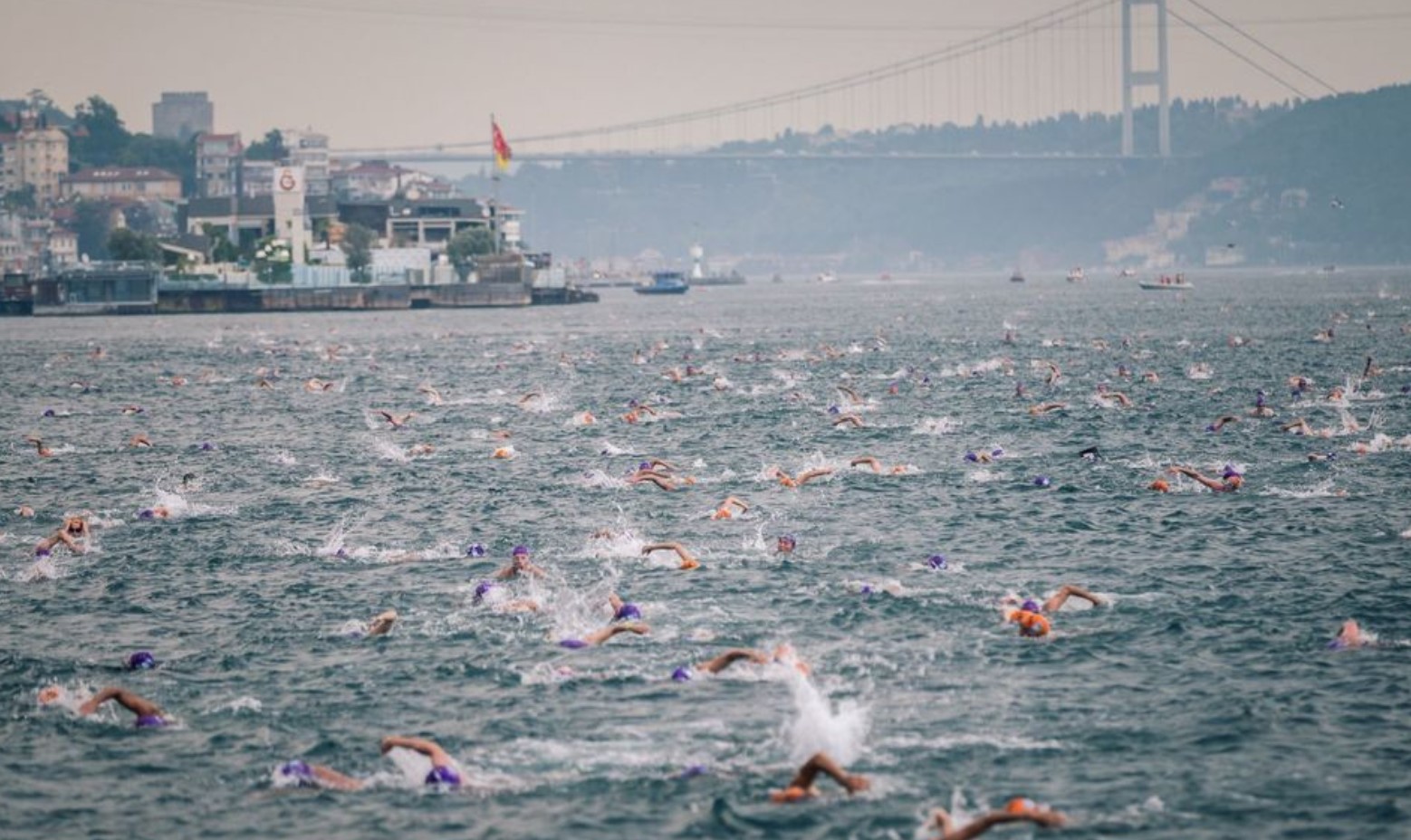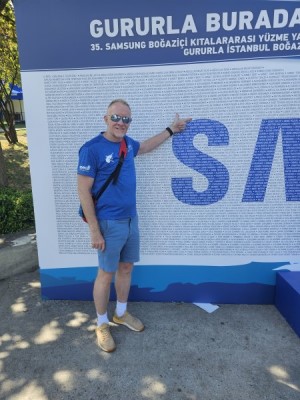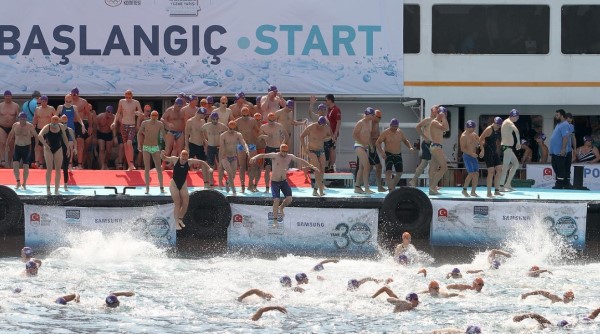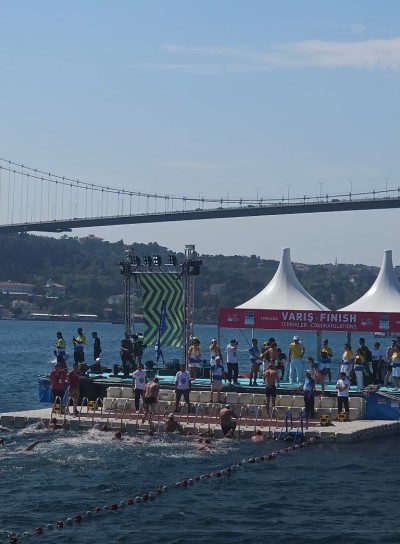Cross Continental Swim
On 20th August 2023, I took part in the 35th edition of the Cross-Continental Swimming Race in Istanbul, Turkey.

The first event took place on July 23, 1989, with just 64 men and 4 women, all from Turkey taking part. In 1992, the event gained "international" status as 22 swimmers from Czechoslovakia and two from the United States joined the race.
Numerous notable swimmers from around the globe have taken part, including Mark Spitz and Ian Thorpe. The oldest participant has been Levent Aksut at the age of 85. These days the event attracts over 2,000 swimmers from more than 50 countries
The swimming route begins at Kanlica Pier in the Asian side of Istanbul, just north of the Fatih Sultan Mehmet Bridge, and finishes at Cemil Topuzlu Park in Kurucesme, north of the Bosphorus Bridge on the European side with a total distance of 4 miles or 6.5km.

The race proceeds downstream, following the dominant surface current of the Bosphorus. And, if you stay in the centre of the Strait, you will catch the fastest currents, although those waters are cooler and could feel quite chilly.
The Swim
On Saturday, the day before the race, I went down to the registration area to get my race cap, timing chip and goodie-bag. Everything went smoothly and there was ample time to view the Race Director's instructions on the big screens

For this race, I received the race number 0222 and went to look at the Bosphorus. There was a lot of chop on the water and the wind was blowing at about 25kph. It could be a difficult swim!
I'd walked from the hotel to the registration area, which is also where all swimmers board the ferries to the start of the race. It didn't look far on the map and thought I'd maybe walk to the start on the Sunday as a bit of a warm-up. What I hadn't realised is just how hilly and crowded Istanbul roads are and how hot it was even early in the morning. Anyway, this 'practice' served well and highlighted that I'd need a taxi the next morning.
Well, that taxi didn't turn up! Cue a few minutes of unnecessary stress. Fortunately (?), I'd listed this possibility on my risk assessment and thus allowed an extra 30 minutes. Though, at one point, I thought I was going to have to run to the start, which wouldn't have been ideal. At least the wind had dropped.
Cemil Topuzlu Park was what you'd expect on the morning of any big sporting event. Athletes everywhere, moving in seemingly stochastic patterns. Queues for the coffee stall, queues for the toilets, queues for changing rooms. The final queue was one for the three ferries which would take us to the start at Kanlica Pier.
At this point I was inspected and thought there'd be no problem as I wasn't wearing a watch or anything else that could be deemed dangerous to other swimmers. But, no, the lady checking numbers, etc, decided I had to go and cut my finger nails (and I don't wear them long!). So, into another queue with just about half the athletes there, for nail clippers. I guess 80kg landing on your head when we jump in, isn't as dangerous as a slightly long finger nail.
The ferries were supposed to be sorted according to age (race number), but that distinction didn't seem to exist on race day. Everyone just sat down where they wanted.
Eventually the three ferries departed for the 20/30 minute voyage to the starting point.
When we arrived, there was another 30-minute delay whilst they built the start pontoon against the third (last) ferry. Tension could be felt throughout the boat, with most swimmers expending nervous energy pacing up and down to the exit door and back to their seats.
At 10am the klaxon went and the race started. I was in the second ferry, so still had around 10 minutes to wait before downing an energy gel, throwing off the slippers we'd been given for the trip and crossing the timer-start mat.

At this point I took a couple of moments to look up and take in a brief look at the view. The sight of hundreds of people in the water swimming across the Bosphorus is a sight to behold. What a magnificent backdrop for a swim!
One glance to make sure the water was clear and I jumped in. Having prepared myself for a bit of a thermal shock, I was pleasantly surprised. It felt warm. No time to wait, though, the risk of somebody landing on you in the water is real, so I put in a quick 50m sprint to get away, then concentrated on settling my breathing and hitting a rhythm.
Once all of my systems felt in control, I started navigating as suggested by the race director. First towards the far (European) tower of the nearest suspension bridge (Fatih Sultan Mehmet bridge). When I felt a slight change of water temperature it was time to aim for the middle of the bridge. This is where swimmers pick up the strong currents from the Black Sea.
Very soon, I was speeding along the Strait. Take a sighting stroke and I could see a castle's ramparts not far down the route on the far bank. Six strokes later, on the next sighting, and I'm level with the ramparts. One more cycle and I look up to see the castle in my rear-view mirror. The current was strong as a result of the previous day's weather!
I'd envisaged a bit of carnage in the water with so many swimmers departing in a short interval; hits on the head, kicks in the face and swimmers coming across my path. But none of this happened. I guess the Bosphorus is so wide that 2,5000 swimmers just disperse to a low density.
With both of those factors in place, it was possible to regulate breathing and stroke to a level that made the whole swim quite enjoyable. I took an occasional 'pit stop' just to take a look around and take in what I was actually doing, safe in the knowledge even then the current was whizzing me towards the finish.
Around 50 minutes after starting, I passed Galatasaray Island to my right, about 150m away as the Race Director instructed. Time to turn towards the finish.
And this is where the swim turned less-enjoyable.
It quickly became apparent that the currents were stronger than normal. I was going too fast along the middle of the Strait to hit the finish. So, I changed my direction towards a massive Turkish flag, which I knew to be several hundred metres North of the finish.
My efforts were to no avail. The current was still too strong and I was heading under the Bogazici bridge and out towards the Sea of Marmara! Actually, this would never happen because the race organisers position safety boats under the bridge to pick up those who cannot swim back.

It was time for a 400m maximal effort. Swimming into the current, now with increased chop, and waves coming directly into my breathing pattern, was tiring to say the least. A couple of times I flipped onto my back to judge progress away from the bridge, and each time it seemed like I'd only moved a few metres. At least I could see that I wasn't on my own; hundreds of other swimmers were dealing with the same issue, including many who had swum the race multiple times before.
Afterwards, I'd be asked if Poetry (a Lord Byron reference) came into my head during the swim. But at this point my thoughts were a bit more industrial-language than that.
Eventually the effort paid a dividend and I broke out of the current. Things suddenly became easier and I could swim back to the finish. Up the ladder, across the timing mat, and I'd done it - I am now a Cross Continental Swimmer.
Interview with Sky News following the swim
